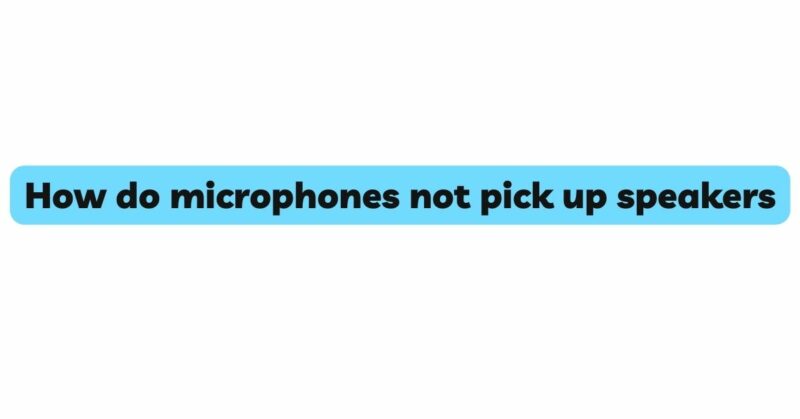In the realm of audio technology, the dynamic interplay between microphones and speakers is at the heart of communication, entertainment, and content creation. Yet, a challenge that often arises is the prevention of microphones picking up audio from nearby speakers. This phenomenon, characterized by feedback, echo, and distortions, can mar the quality of recordings and live events. This article delves into the techniques and strategies that can effectively prevent microphones from picking up speaker audio, ensuring clean, crisp sound and an enhanced audio experience.
1. Understanding Microphone-Speaker Interaction
The key to preventing microphones from picking up speaker audio lies in understanding the fundamentals of sound propagation and device positioning. Feedback occurs when the output audio from speakers is captured by a microphone and then re-amplified, creating a loop of sound. This phenomenon is often a result of the sound waves emitted by the speakers reaching the microphone and being recorded again.
2. Optimal Microphone Placement
Strategic microphone placement is the foundation of preventing audio pickup from nearby speakers. Position the microphone away from the speakers and their direct path of sound emission. Experiment with angles and distances to find the optimal position that minimizes the chances of capturing speaker audio.
3. Directional Microphones
Selecting the right microphone type can be instrumental in mitigating speaker audio pickup. Directional microphones, such as cardioid, supercardioid, or shotgun microphones, have focused pickup patterns that capture sound primarily from specific directions while minimizing sound from other angles. These microphones are particularly effective in rejecting sound emanating from nearby speakers.
4. Isolation and Acoustic Treatment
Creating an acoustically treated environment can substantially reduce the chances of microphone pickup of speaker audio. Sound-absorbing materials, such as acoustic panels, foam, and diffusers, can help minimize sound reflections and dampen unwanted audio that might reach the microphone.
5. Noise Cancellation and Equalization
Employ advanced audio processing tools like noise cancellation and equalization. Noise cancellation can help eliminate unwanted frequencies that contribute to feedback, while equalization can adjust the frequency response to prevent resonances that lead to audio pickup.
6. Headphones for Monitoring
Using headphones during recording or live events is an effective technique to prevent microphone pickup of speaker audio. By wearing headphones, the sound from the speakers is isolated from the microphone, breaking the feedback loop and ensuring clear audio transmission.
7. Noise Gates and Compression
Incorporate noise gates and compression into your audio setup. Noise gates automatically mute the microphone when the input falls below a specified threshold, silencing unwanted sound during moments of silence. Compression helps regulate audio levels, reducing the likelihood of sudden audio spikes that could trigger feedback.
8. Optimize Audio Levels
Careful adjustment of audio levels is paramount to preventing speaker audio pickup. Setting appropriate input and output levels ensures that sound is captured and reproduced at an optimal volume without causing feedback.
9. Software and System Settings
Thoroughly review and configure audio settings on your computer or audio interface. Disable any settings that route microphone audio to speakers and vice versa. Ensure that software settings do not inadvertently create a feedback loop.
10. Acoustic Isolation and Barriers
Physical barriers and acoustic isolation can be effective in preventing microphone pickup of speaker audio. Isolation shields, foam panels, and isolation mounts can create a barrier between the microphone and speakers, blocking direct sound transmission.
11. Professional Consultation
For complex setups or persistent issues, seeking professional consultation can yield valuable insights. Audio engineers and experts can provide tailored solutions, recommend equipment adjustments, and implement advanced techniques to eliminate speaker audio pickup.
12. Continuous Testing and Adjustment
Regular testing and adjustment are essential to ensure the effectiveness of your setup. Conduct tests with different configurations to verify that the microphone is not picking up speaker audio, and make adjustments as necessary.
Conclusion
The prevention of microphones picking up audio from nearby speakers is an intricate dance between strategic positioning, microphone choice, acoustic treatment, and technological tools. By mastering the principles of sound propagation, leveraging directional microphones, and employing techniques such as headphones, noise gates, and acoustic isolation, you can achieve pristine audio quality free from unwanted feedback. Armed with these techniques, you can create an audio environment that fosters clear communication, exceptional recordings, and immersive experiences. As technology evolves and audio demands continue to grow, the ability to prevent speaker audio pickup becomes a crucial skill for audio enthusiasts, professionals, and content creators alike.


